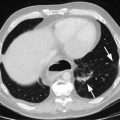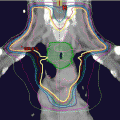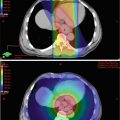Treatment
Histology
No. of patients
R0 resection rate
Pathologic CR rate
Survival
Local failure
References
Median
Overall
Periop ECF + surgery
Adeno
250
69 %
0 %
24 months
5 years 36 %
14 %
Cunningham et al. [12]
Surgery
253
66 %
N/A
20 months
5 years 23 %
21 %
Periop 5FU/Cis + surgery
Adeno
109
87 %
NS
NS
5 years 38 %
24 %
Ychou et al. [13]
Surgery
110
74 %
N/A
NS
5 years 24 %
26 %
Periop 5FU/Cis + surgery
Adeno
(54 %) + SCC
213
62 %
2.5 %
14.9 months
3 years 23 %
32 %
Kelsen et al. [14]
Surgery
227
59 %
N/A
16.1 months
3 years 26 %
31 %
Preop 5FU/Cis + surgery
Adeno (66 %) + SCC
400
60 %
NS
16.8 months
5 years 23 %
19 %
Surgery
402
54 %
N/A
13.3 months
5 years 17 %
17 %
Preop 5FU/LV/Cis + surgery
Adeno
72
82 %
7.1 %
64.6 months
2 years 73 %
NS
Schumacher et al. [16]
Preoperative Chemoradiation
The seminal phase III US Radiation Therapy Oncology Group (RTOG) trial 85-01 demonstrated the superiority of chemoradiation over radiation alone [18]. This nonoperative study compared standard-fractionation radiation (64 Gy) vs. radiation (50 Gy) plus concurrent 5-FU/cisplatin. The trial was stopped when data from 121 patients showed an improved median OS in favor of chemoradiation (12.5 months vs. 8.9 months). Two-year survival was also improved in the chemoradiation group (38 % vs. 10 %), as was 5-year survival (21 % vs. 0 %) [19]. Although the majority of patients treated on this trial had SCC, long-term survival was also seen in the small number of adenocarcinoma patients on the trial, with 13 % of patients alive at 5 years.
In addition to a survival benefit, disease recurrence was significantly reduced by the addition of chemotherapy to radiation. At 1 year, recurrent disease was observed in 62 % of the group that received radiation vs. 44 % in the chemoradiation arm. Distant recurrence rates were 38 % and 22 % respectively. Based on this study, chemoradiation was established as the standard-of-care in the nonsurgical management of locally advanced esophageal SCC.
Since then, preoperative chemoradiation has been evaluated extensively in trials of esophageal cancer. Six contemporary randomized trials have compared preoperative chemoradiation followed by surgery vs. surgery alone [20–25]. Of these, three have been positive and revealed a survival benefit for this approach. These results are summarized in Table 13.2.
Table 13.2
Results of phase III preoperative chemoradiation trials in esophageal and GE junction cancer (Results in BOLD are statistically significant)
Treatment | Histology | No. of patients | R0 resection rate | Pathologic CR rate | Survival | Local failure | References | |
|---|---|---|---|---|---|---|---|---|
Median | Overall | |||||||
Preop CRT | Adeno (76 %) + SCC | 50 | 45 % | 24 % | 16.9 months | 3 years 30 % | 19 % | Urba et al. [22] |
Surgery | 50 | 45 % | N/A | 17.6 months | 3 years 16 % | 42 % | ||
Preop CRT | Adeno | 58 | NS | 25 % | 16 months | 3 years 32 % | NS | Walsh et al. [23] |
Surgery | 55 | N/A | 11 months | 3 years 6 % | ||||
Preop CRT | SCC | 143 | 81 % | 26 % | 18.6 months | 5 years 26 % | NS | Bosset et al. [20] |
Surgery | 139 | 69 % | N/A | 18.6 months | 5 years 26 % | |||
Preop CRT | Adeno (63 %) + SCC + other | 128 | 80 % | 9 % | 22.2 months | NS | 15 % | Burmeister et al. [21] |
Surgery | 128 | 59 % | N/A | 19.3 months | NS | 26 % | ||
Preop CRT | Adeno (75 %) + SCC | 30 | NS | 40 % | 4.5 years | 5 years 39 % | NS | Tepper et al. [24] |
Surgery | 26 | N/A | 1.8 years | 5 years 16 % | ||||
Preop CRT | Adeno (74 %) + SCC | 178 | 92 % | 29 % | 49.4 months | 3 years 58 % | NS | Van Hagen et al. [25] |
Surgery | 188 | 69 % | N/A | 24.0 months | 3 years 44 % | |||
A potential new standard-of-care was established by the rigorously conducted Dutch CROSS trial [25]. In this study of 366 evaluable patients with esophageal tumors (of which 75 % and 65 %, respectively, were adenocarcinomas and lymph node positive by endoscopic ultrasound, or EUS), patients were randomized to preoperative carboplatin/paclitaxel combined with 41.4 Gy of radiation vs. surgery alone. Preoperative chemoradiation resulted in an improvement in R0 resection rates (92 % vs. 67 %, p < 0.001), in a pathologic complete response (pCR) rate of 29 % (23 % for adenocarcinoma and 49 % for SCC) and in improved OS compared to surgery alone (median OS 49.4 vs. 24.0 months, 3-year OS 58 % vs. 44 %, p = 0.003). Preoperative therapy was also relatively well-tolerated, with mostly grade 3 toxicities noted in only 20 % of patients (13 % non-hematologic, 7 % hematologic). There did appear to be a greater degree of benefit for patients with SCC vs. adenocarcinoma histology (univariate HR for death 0.45 vs. 0.73), but all patients derived benefit.
While this study demonstrates a clear benefit for chemoradiation, it is not possible to definitively conclude that carboplatin/paclitaxel is the preferred regimen combined with radiation relative to standard 5-FU/cisplatin utilized in other trials. Nevertheless, the pCR rate of 49 % in SCC is the highest ever reported in a phase III trial, while the pCR rate of 23 % for adenocarcinomas compares favorably to other phase II/III studies. Coupled with the ease of administration and tolerability, carboplatin/paclitaxel may be considered the new standard-of-care and the reference regimen for future trial design. Some insight into the relative merits of carboplatin/paclitaxel vs. a 5-FU/platinum regimen may come from the ongoing CALGB 80803 study (see below).
Overall, many of the other randomized trials conducted are associated with methodological concerns (including the lack of rigorous pre-therapy staging with EUS and/or laparoscopy) and are significantly smaller than randomized preoperative chemotherapy trials (e.g., the positive CALGB 9781 study only enrolled 56 patients). While the results of these trials are conflicting, they do at a minimum suggest improved curative resection rates as well as decreased local recurrence.
A benefit for preoperative chemoradiation is supported by the previously discussed meta-analysis, in which 13 randomized trials of preoperative chemoradiation (including the five trials discussed above) were analyzed [17]. Preoperative chemoradiation was associated with a decreased risk of all-cause mortality of 25 % (HR 0.75; 95 % CI 0.59–0.95, p = 0.02) in patients with adenocarcinoma histology vs. surgery alone.
Preoperative Chemoradiation for Early-Stage Disease
While the studies above have focused on locally advanced tumors (which, by contemporary standards, would include staging with EUS and comprise mostly uT3-4 N+ tumors), the recently published French FFCD 9901 study treated 195 patients with early-stage cT1-2Nany or cT3N0 tumors with preoperative 5-FU/cisplatin and radiation and surgery vs. surgery alone [26]. Seventy-two percent of patients on this study had SCCs and 24 % and 74 %, respectively, had cT1 and cN0 tumors. This study revealed a strikingly high 93 % R0 resection rate in the surgery-alone arm, which was not improved with preoperative chemoradiation. Similarly, median DFS and OS were not significantly different in both arms, but in-hospital postoperative mortality was significantly increased in the chemoradiation arm (11.1 % vs. 3.4 %, p = 0.049).
These results are somewhat surprising: despite the lack of improvement in R0 resection rates, locoregional recurrence was reduced in the chemoradiation arm (22.1 % vs. 28.9 %, p = 0.02); on the other hand, the rate of distant recurrence was not significantly different between both arms (22.5 % vs. 28.9 %, p = 0.31). In addition, the unexpectedly high postoperative mortality in the chemoradiation arm – compared with 4 % in both treatment arms of the CROSS study – might have obscured a small survival benefit from chemoradiation.
Nevertheless, these results are not necessarily inconsistent with other published data. An accepted approach – discussed below – is definitive chemoradiation without surgery for patients with SCC who achieve a clinical CR. Since 72 % of patients on this study had SCC tumors, it arrives at the complementary conclusion that SCC patients who do undergo chemoradiation should not undergo mandatory surgery. Similarly, these results are concordant with current guidelines by the National Comprehensive Cancer Network, which recommend surgery alone for patients with cT1N0 tumors.
Preoperative Chemoradiation Versus Chemotherapy
The possible superiority of preoperative chemoradiation over preoperative chemotherapy was suggested by the German POET (PreOperative Chemotherapy or Radiochemotherapy in Esophagogastric Adenocarcinoma Trial) study, in which patients with GE junction adenocarcinomas were randomized to either 5-FU/leucovorin/cisplatin followed by surgery vs. 5-FU/leucovorin/cisplatin followed by chemoradiation with cisplatin/etoposide and then surgery [27]. One hundred and nineteen eligible patients were randomized before the trial was closed due to poor accrual, limiting the power of this study to detect a difference between the treatment groups. Nevertheless, patients who received preoperative chemoradiation had a higher pCR rate (15.6 % vs. 2 %, p = 0.03) and tumor-free lymph node status (ypN0 64.4 % vs. 36.7 %, p = 0.01) than those who received preoperative chemotherapy. There were also trends toward an improvement in local control (76.5 % vs. 59 %, p = 0.06) and in 3-year OS (47.4 % vs. 27.7 %, p = 0.07) for the chemoradiation group.
A similar nonsignificant trend toward improved outcomes with preoperative chemoradiation over chemotherapy was also suggested in the meta-analysis by Sjoquist et al., which revealed an all-cause mortality HR of 0.88 (95 % CI 0.76–1.01, p = 0.07) favoring chemoradiation.
Definitive Chemoradiation Without Surgery
Two randomized European trials have compared definitive chemoradiation vs. chemoradiation followed by surgery in esophageal SCC patients [28, 29]. Taken together, both studies suggest that local control is improved by subsequent surgery but that there is no clear improvement in survival.
In the setting of definitive chemoradiation, FOLFOX (5-FU/leucovorin/oxaliplatin) also appears to be a comparable option to 5-FU/cisplatin based on the French PRODIGE5/ACCORD17 study, which randomized 267 patients to either regimen with radiation as definitive therapy [30]. Eighty-five percent of the patients on this study had SCC. Survival and toxicities were comparable in both arms.
An interesting question that arises from one of these studies (the FFCD 9102 trial) is whether patients who do not respond to initial therapy benefit from subsequent surgery. In this study, patients received initial treatment with 5-FU/cisplatin and radiation; only responders were subsequently randomized to surgery vs. additional chemoradiation. In an abstract presentation, the authors discussed the outcome of the 192 of the 451 registered patients who were not randomized to further protocol therapy after initial chemoradiation, primarily because of a lack of response but also because of medical contraindication or patient refusal [31]. Of these nonrandomized patients, 112 subsequently underwent surgery, with 80 undergoing R0 resections. The median OS for the patients who underwent surgery was significantly superior to the median OS of those who did not (17.3 vs. 6.1 months) and was comparable to the median OS of the patients who were randomized. While there are clear limitations and potential strong confounders to such an analysis, these data suggest that salvage esophagectomy may be beneficial for a subset of patients who do not respond to initial therapy.
On the other hand, there are no randomized data in patients with adenocarcinomas to suggest that definitive chemoradiation is comparable to chemoradiation and surgery. However, given the significant morbidity and mortality associated with esophagectomy even at high volume institutions, one option is to closely follow adenocarcinoma patients who achieve a clinical CR to preoperative chemoradiation – especially those who are relatively frail –with repeat endoscopy and imaging. Those patients who develop locoregional failure without distant metastases may then be evaluated for salvage esophagectomy.
A major concern about such an approach is that postoperative complications and deaths may significantly increase when surgery is delayed beyond the standard 6–8 week break following chemoradiation. The group at MD Anderson Cancer Center recently reported on their experience in 65 patients with esophageal adenocarcinoma who underwent salvage esophagectomies a median of 216 days following chemoradiation [32]. When compared to matched patients who underwent planned esophagectomy after chemoradiation, postoperative complications and survival did not appear to be different. In addition, the RTOG 0246 study evaluated induction chemotherapy with 5-FU/cisplatin/paclitaxel and chemoradiation with 5-FU/cisplatin in 43 patients with locally advanced esophageal cancer; salvage surgery was reserved for patients with locally persistent/recurrent disease [33]. Although the study did not meet its primary endpoint of improving 1-year survival to 77.5 %, it did suggest that postoperative mortality was not increased by delaying surgery. Therefore, such an approach can be considered for select patients at institutions with significant experience in this strategy.
Positron Emission Tomography-Directed Therapy
[18 F]2-fluoro-deoxy-D-glucose positron emission tomography (FDG-PET) scanning is emerging as an important tool to investigate response to therapy. Several studies in esophagogastric tumors have demonstrated that the degree of response detected by PET following preoperative chemoradiation [34, 35] or chemotherapy [36, 37] is highly correlated with pathologic response at surgery and with patient survival.
The German MUNICON trial evaluated the strategy of taking patients with locally advanced GE junction adenocarcinomas with a suboptimal response to 2 weeks of induction chemotherapy with 5-FU/cisplatin – as determined by serial PET scans – directly to surgery, instead of continuing with presumably ineffective chemotherapy. Patients with a metabolic response by PET (defined as ≥35 % reduction in standard uptake value between baseline and repeat PET scan) continued with an additional 12 weeks of chemotherapy prior to surgery [38]. This trial revealed a significantly improved R0 resection rate (96 % vs. 74 %, p = 0.002), major pathologic response rate (58 % vs. 0 %, p = 0.001), median event-free survival (29.7 vs. 14.1 months, p = 0.002) and median OS (median not reached vs. 25.8 months, p = 0.015) for PET responders vs. PET nonresponders. The outcome for PET nonresponders referred for immediate surgery was similar to the outcome of such patients in an earlier trial who completed 3 months of preoperative chemotherapy [36], indicating that nonresponding patients were not compromised by referral to immediate surgery. These results therefore support the early discontinuation of inactive preoperative chemotherapy in PET nonresponder patients.
Stay updated, free articles. Join our Telegram channel

Full access? Get Clinical Tree






